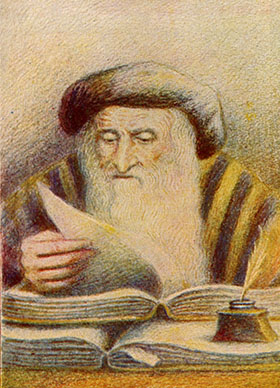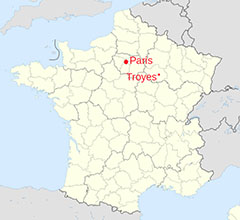 ‘Rashi’ is an acronym for Rabbi Shlomo ben Itzhak, also known as Rabbi Shlomo Itzhaki [Rabbi Solomon, son of Isaac] in English. He is the pre-eminent commentator on nearly the entire Bible and the Babylonian Talmud. His writings are the key works of commentary on both the written and oral Torah.
‘Rashi’ is an acronym for Rabbi Shlomo ben Itzhak, also known as Rabbi Shlomo Itzhaki [Rabbi Solomon, son of Isaac] in English. He is the pre-eminent commentator on nearly the entire Bible and the Babylonian Talmud. His writings are the key works of commentary on both the written and oral Torah.
Rashi was born to a prominent family in Troyes, France in 1040. His father was a scholar (whom Rashi occasionally quotes) and his mother was the sister of a famous liturgical writer, Simeon ben Isaac. Rashi was descended from Rabbi Yochanan HaSandler, a Talmudic sage, who in turn could trace his lineage to King David.
Numerous legends tell of events preceding Rashi’s birth. According to one story, Rashi’s father threw a priceless pearl into the sea rather than sell it for idolatrous purposes. His reward was Rashi. Another account claims that Rashi’s mother pushed violently against a wall while pregnant with Rashi; the wall bent inwards to protect her belly. One Chassidic legend tells that Abraham only agreed to remove Isaac from the sacrificial altar upon learning that one of Isaac’s descendants would be Rashi.

As a young man Rashi studied with some of the greatest sages of his time, including the disciples of Rabbi Gershom Meor HaGolah and Rabbi Yaakov ben Yakar. Rashi also travelled extensively. At the age of 25, he returned to his home town of Troyes. By the age of 30 he had opened an academy there, all the while supporting himself as a wine merchant.
Rashi’s commentary on the Bible and the Talmud had a profound affect on Jewish learning and the whole idea of the Jewish book. It helped make the notion of a running textual commentary one of the defining forms of Jewish intellectual culture. His commentary soon supplemented most editions of these texts.
Rashi’s commentary covers the entire Bible, except Chronicles. Rashi’s commentary on the Bible is a model of brevity, giving the impression that he is unwilling to waste a single word. The commentary has a unique, pleasant, even poetic style, bringing the Torah to life as a story, and illuminating its meaning like a powerful flashlight.
Rashi’s indispensable commentary on Talmud was written as a series of notebooks, called kuntresim. Rashi uses his knowledge of history, logic, philology and psychology to explain obscure texts in just a few short words or lines.
Rashi’s biblical commentary interested Christians as well, and was the first Hebrew book ever printed, in 1475. The first printed edition of the Talmud, and virtually every one afterwards, contains Rashi’s commentary.
When preparing Rashi’s commentary to print, the printer had a dilemna: how to make Rashi’s commentary easily distinguishable from the text of the Bible so the reader would not mistake the commentary for the holy text. A simple solution was found – using a special font for Rashi’s commentary. Ever since that time, it has been a Jewish tradition to print Rashi’s commentary using that special font, now know simply as ‘Rashi script’.

while the bottom line shows the same letters in Rashi script.
Links
- Aish: Reverence for Rashi
- Chabad: Rashi: Rabbi Shlomo Yitzchaki (note: gives dates according to the Jewish calendar, not the secular/Gregorian calendar)
- Jewish Virtual Library: Rashi (Rabbi Shlomo Itzhaki)
- Jewish Women’s Archive: Rashi (explores Rashi’s attitudes to and about women)
- Jewish Encyclopedia: Rashi (Solomon bar Isaac)
- Jewish Magazine: Rashi
- My Jewish Learning: Who Was Rashi?


